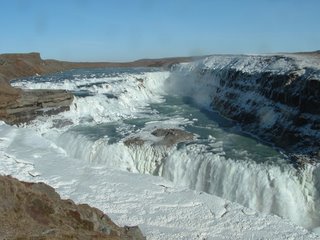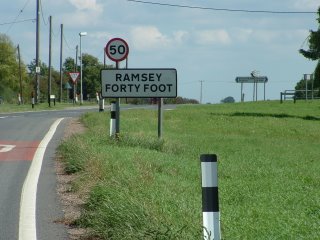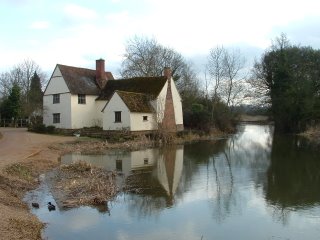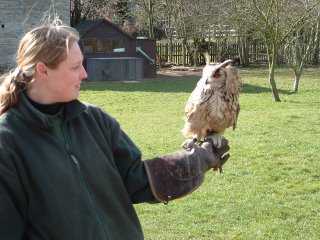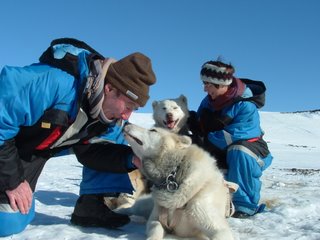


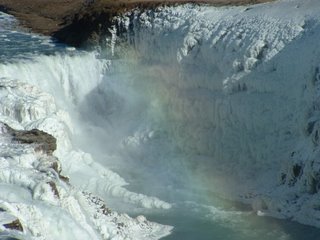
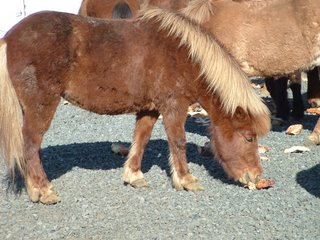

Above is a picture of an Iceland Horse -while looking like a Shetland, this breed is home grown and a remarkably strong animal. It can easily carry two people (as long as their legs are not too long!) and they survive the climate becaue of their long thick shaggy coats.
Next to it is another photo of the Gulfoss waterfall which although partly frozen is still a most spectacular sight. At the right is a picture of the Horses Main waterfall and you can see that a salmon ladder has been constructed at the left hand side of the falls. This was the first attempt to build such a structure and it was unsuccessful for two reasons. It did not have the right inclination for one and there were no salmon in the river either!! Carol was unfortunately sick in the bus shortly after this which was a bit embarrassing for her, but the driver was up to the task and cleaned everything up with no fuss. Not sure what caused this, but while she felt it was the carrot cake she had eaten at Gulfoss, our lovey guesthouse lady told us later that a virus was going around which seemed to only last for 4 hours -and certainly Carol had no ill effects the next day.
So on Sunday we picked up a hire car - left hand drive Renault station wagon at a cost of $160 for the day! We had arranged to go dog sledding on a glacier which was 180kms from town. After giving Carol several very bad moments by nearly sideswiping parked cars, and mounting the footpath on her side of the road, I finally got the hang of it and we drove with no further mishaps.
We eventually arrived at the track which led from the main road up to the glacier - and when I say track I mean goat track. But by being very careful we manage to avoid the larger rocks, crossed a couple of ice and snow patches and finally (and thankfully) arrived at the site. There were dozens of 4wds parked there with trailers carrying snowmobiles which seemed to be the most popular sport.After as short wait we saw a teams of dogs pulling a sled hurtling down the hill towards us so we knew were in the right place.
Having been kitted out with zipper overalls and introduced to the dog team, and the leader "Gandi" in particular, we took our seat on the sled and the "Musher" shouted out and we were off. The dogs are not Huskies, which the musher assured us were the racehorses of dogs. Ours were Greenland sled dogs bred by the army in Greenland as pure working dogs and capable of sustained power. We went up quite a few slopes, and while the dogs only walked they kept us moving. Going downhill was exhilirating and the musher put ropes under the sled to act as brakes so that we didn't run up the dog'd bums!!At the top of the glacier we had a break to take in the panoramic views of mountains and out across the Atlantic ocean which shimmered in the background. Too expansive to attempt to photograph. While resting we were encouraged to pat and fuss with the dogs who acted like great big sooks. Then it was back on board and off to the base. In all we had about an hour on the trip and it was a once in a lifetime experience. At the base we had to again fuss over the dogs as a way of thanking them for their efforts.
When finally got back to Sunna our host booked a table for us at a fish restaraunt that she recommended. It was superb, and although Carol was a bit tired and couldn't eat all her meal, yours truly wolfed the lot after his exhaustiing driving experie nce!!
The next morning I had to return the car and had been advised to fill it with petrol rather than pay the hire compa nys extortionate price. In some trepidation I drove off looking for a servo and took a wrong turn finishing up on the main highway going out of town! Of course I hadn't taken a map with me and became more than a little stressed as it was peak hour. Thankfully our guesthoouse was next door to the Cathedral and I spotted it's tower and headed on all sorts of streets until I arrived back at Sunna. Then I started out again determined to make straight for the hire company and bugger the expense. I was also a bit worried because we had managed to shed a wheel trim somewhere somehow(hitting the footpath Len?). Blow me down when I got there I told them I had not filled up - so they asked me if I would like a driver to take me back to the guesthouse and fill up with petrol on the way!!Sheer heaven - and they didn't even check out the car!!
And so our day of departure. We had booked a tour which took us to the Blue Lagoon where we were to have a couple of hours relaxing iin the Lagoon before being picked up again and taken to the airport. The Blue Lagoon is a geothermal pool with milky blue warm water and a sandy bottom extending over a considerable area. After we had changed into our bathers, we did a quick dash from the change rooms into the pool and stayed there basking in the warm water. Carol applied the silica mud to her face and her complexion has never looked better!
Then it was the airport where, suprisingly we had the best value meal of our stay -most unlike an airport. A fitting finale to a truly wonderful visit.
Sorry about the photos all being up at the top of this blog - I can't seem to get them into places that would be more appropriate.
